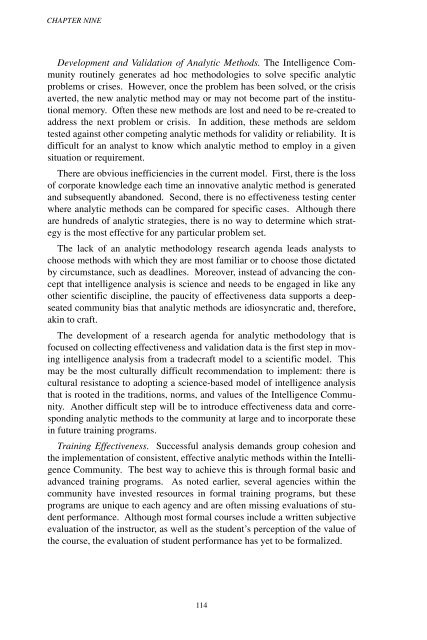Analytic Culture in the U.S. Intelligence Community (PDF) - CIA
Analytic Culture in the U.S. Intelligence Community (PDF) - CIA
Analytic Culture in the U.S. Intelligence Community (PDF) - CIA
Create successful ePaper yourself
Turn your PDF publications into a flip-book with our unique Google optimized e-Paper software.
CHAPTER NINE<br />
Development and Validation of <strong>Analytic</strong> Methods. The <strong>Intelligence</strong> <strong>Community</strong><br />
rout<strong>in</strong>ely generates ad hoc methodologies to solve specific analytic<br />
problems or crises. However, once <strong>the</strong> problem has been solved, or <strong>the</strong> crisis<br />
averted, <strong>the</strong> new analytic method may or may not become part of <strong>the</strong> <strong>in</strong>stitutional<br />
memory. Often <strong>the</strong>se new methods are lost and need to be re-created to<br />
address <strong>the</strong> next problem or crisis. In addition, <strong>the</strong>se methods are seldom<br />
tested aga<strong>in</strong>st o<strong>the</strong>r compet<strong>in</strong>g analytic methods for validity or reliability. It is<br />
difficult for an analyst to know which analytic method to employ <strong>in</strong> a given<br />
situation or requirement.<br />
There are obvious <strong>in</strong>efficiencies <strong>in</strong> <strong>the</strong> current model. First, <strong>the</strong>re is <strong>the</strong> loss<br />
of corporate knowledge each time an <strong>in</strong>novative analytic method is generated<br />
and subsequently abandoned. Second, <strong>the</strong>re is no effectiveness test<strong>in</strong>g center<br />
where analytic methods can be compared for specific cases. Although <strong>the</strong>re<br />
are hundreds of analytic strategies, <strong>the</strong>re is no way to determ<strong>in</strong>e which strategy<br />
is <strong>the</strong> most effective for any particular problem set.<br />
The lack of an analytic methodology research agenda leads analysts to<br />
choose methods with which <strong>the</strong>y are most familiar or to choose those dictated<br />
by circumstance, such as deadl<strong>in</strong>es. Moreover, <strong>in</strong>stead of advanc<strong>in</strong>g <strong>the</strong> concept<br />
that <strong>in</strong>telligence analysis is science and needs to be engaged <strong>in</strong> like any<br />
o<strong>the</strong>r scientific discipl<strong>in</strong>e, <strong>the</strong> paucity of effectiveness data supports a deepseated<br />
community bias that analytic methods are idiosyncratic and, <strong>the</strong>refore,<br />
ak<strong>in</strong> to craft.<br />
The development of a research agenda for analytic methodology that is<br />
focused on collect<strong>in</strong>g effectiveness and validation data is <strong>the</strong> first step <strong>in</strong> mov<strong>in</strong>g<br />
<strong>in</strong>telligence analysis from a tradecraft model to a scientific model. This<br />
may be <strong>the</strong> most culturally difficult recommendation to implement: <strong>the</strong>re is<br />
cultural resistance to adopt<strong>in</strong>g a science-based model of <strong>in</strong>telligence analysis<br />
that is rooted <strong>in</strong> <strong>the</strong> traditions, norms, and values of <strong>the</strong> <strong>Intelligence</strong> <strong>Community</strong>.<br />
Ano<strong>the</strong>r difficult step will be to <strong>in</strong>troduce effectiveness data and correspond<strong>in</strong>g<br />
analytic methods to <strong>the</strong> community at large and to <strong>in</strong>corporate <strong>the</strong>se<br />
<strong>in</strong> future tra<strong>in</strong><strong>in</strong>g programs.<br />
Tra<strong>in</strong><strong>in</strong>g Effectiveness. Successful analysis demands group cohesion and<br />
<strong>the</strong> implementation of consistent, effective analytic methods with<strong>in</strong> <strong>the</strong> <strong>Intelligence</strong><br />
<strong>Community</strong>. The best way to achieve this is through formal basic and<br />
advanced tra<strong>in</strong><strong>in</strong>g programs. As noted earlier, several agencies with<strong>in</strong> <strong>the</strong><br />
community have <strong>in</strong>vested resources <strong>in</strong> formal tra<strong>in</strong><strong>in</strong>g programs, but <strong>the</strong>se<br />
programs are unique to each agency and are often miss<strong>in</strong>g evaluations of student<br />
performance. Although most formal courses <strong>in</strong>clude a written subjective<br />
evaluation of <strong>the</strong> <strong>in</strong>structor, as well as <strong>the</strong> student’s perception of <strong>the</strong> value of<br />
<strong>the</strong> course, <strong>the</strong> evaluation of student performance has yet to be formalized.<br />
114
















